The Mekong Express bus company were getting plenty of business from us. As the distance between Phnom Penh and Ho Chi Minh City isn’t great we opted for the bus again rather than flying.
In its favour the bus was cheap and it got us there. It was actually pretty comfortable as well. It was long though, and in the middle of the trip was the Vietnamese border.
The last time we had a border crossing like this I think was getting back into Zimbabwe from Botswana. Slightly disconcertingly the rep on the bus collected everybody’s passports for some kind of collective processing. At one point we were in no mans land between Cambodia and Vietnam with no passport. A tick in the box for flying. We stood in a queue for minutes on end, people kept passing us and walking straight through immigration. Apparently five dollars US go quite a way in queue skipping. Anyway, we made it through eventually (I’m not sure how it would have worked if we’d needed a visa, fortunately we were entering under the 15 day visa exemption for UK citizens).
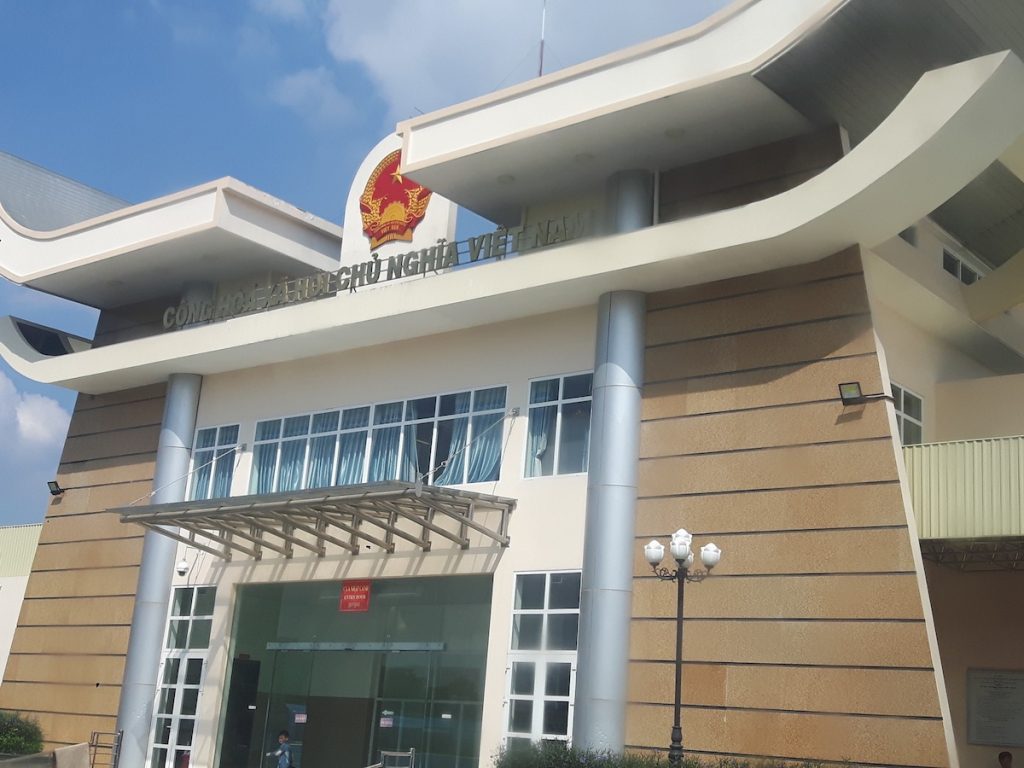
Our first real Vietnam experience was a failed attempt to scam us by a taxi driver. We’d agreed that we could pay him in US dollars and when it came to the fare he wanted to charge a ridiculous $15 and then quickly $10 for a $2, 1.5km trip! He got two dollars.
Our B&B was tucked down a small alleyway just off a busy street. Let’s say it was an ‘interesting’ approach to a B&B. There were people sleeping in shanty lean-tos against some buildings, some seemed residential others seemed to have some sort of business being run from them. Not many of the buildings down the alleyway were hotels or hostels. However, the young lady running ours was welcoming and showed us to our clean room. The whole place (small as it was) had a friendly air about it with loads of quotes about travelling on the walls. The breakfast bit turned out to be interesting too. Eggs (fried or scrambled) served with fresh bread, and served in the reception/foyer/breakfast room area. Full marks for making the most of a small space… (to be clear, we’re talking of a space ofbout 10×8 feet).

Having dropped our bags, we decided to try to find an eatery listed in the Lonely Planet guide. It was located in an alley off a street behind one of the big markets, we found the street, but there was no obvious alley or restaurant. Using the map.me app we worked out that we’d passed the alley. Backtracking, there was an alleyway, dark and quiet, surely there was no restaurant there? It was the only one so we walked down it, and after 15 meters it opened out into a buzzing little street with about five restaurants and bars, full of light and life. The place we were looking for was called Bep Me In, great food and local craft beer to boot. Definitely worth the effort to find it (we actually went back the next night too as it was so good).
With an adventurous day behind us, the first challenge the next morning was to get cash. We’d been warned that sometimes Vietnamese ATMs could be temperamental with foreign cards and that we’d be better off withdrawing money from the bank over the counter. Three trips to two different banks and one morning later we gave up on that and just went to the ATM. One quarter of our time in Ho Chi Minh City gone.
The afternoon was set aside to visit the War Remnants Museum, a museum dedicated to the background of the Vietnam war (or second Indochina war as it is more commonly known locally) and a place full of photographs from the time.
*** Another Warning: The next bit is a potted summary of the Vietnam War (as I understand it) and how the museum covers it. If you don’t want a history lesson feel free to skip ahead a bit…
Firstly, I think it’s fair to say that the museum very firmly gives the Vietnamese angle on the conflict. That’s not to say that it is biased in any way, just that it heavily promotes their view of the conflict. I’m sure there is an equally strong US angle on the whole affair too, but as they say there are two sides to every story, and this museum tells the Vietnamese side corroborated by quotations and statements from verifiable sources.
Outside are some US vehicles and armoury from the time. Planes, helicopters and artillery. These are physical reminders of the time, inside the photographs tell the story of the people and the aftermath of that terrible conflict.
The first gallery is based on a book called Requiem (and shares its name). It is dedicated to those photographers that covered the war but sadly lost their lives whilst doing so. Being quite interested in photography I found this gallery particularly engaging: the amazing images that these people produced (they were of all nationalities and both men and women), some of their stories, their personal sacrifices and the tragic way they lost their lives. Iconic images from the time surrounded us. Some of these were taken by British photographer Larry Burrows (a few of his images are shown here) was just one of those featured in the exhibition.
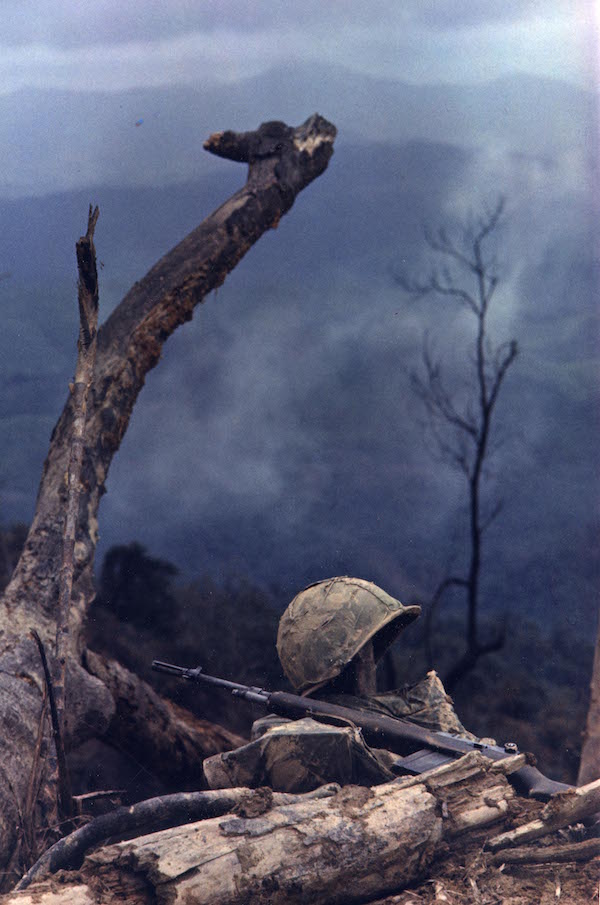
The museum takes you through the background to the conflict, and some of the devastating aftermath.
At the end of WWII, Ho Chi Minh declared independence for the whole of Vietnam. The French however had other ideas, and as there was still conflict between Vietnam and China the French were allowed back in. Ho’s Viet Minh forces soon started guerrilla action against the French, culminating in a 57 day siege after which, on 7 May 1954, 10,000 starving French troops surrendered to the Viet Minh at Dien Bien Phu bringing an end to French colonial involvement in Indochina.
However, this didn’t bring in the unified Vietnam so longed for by Ho. The Geneva Accords returned control of the north to the Viet Minh led by Ho Chi Minh in Hanoi and the south to a government in Saigon led by Ngo Dinh Diem, a fiercely anti-communist Catholic. The North and South were separated by the 17th parallel. They also mandated that national elections should take place to unify the country, these never happened and from 1959 the Minh controlled, communist north started to try to liberate the south.
The Americans also started to become involved during this period, in their fight against communism they couldn’t allow Vietnam to become the next country to fall. Advisors started arriving in 1950, mainly to provide training for local troops, but they were to remain in Vietnam for 25 years.
In the early 60s, the Viet Cong (the Vietnamese Communists formerly known as the Vietnamese Liberation Front) brought the Saigon government to its knees, and an incident in 1964 changed the American’s involvement. Known as the Gulf of Tonkin incident, two US destroyers are alleged to have come under unprovoked attack off the North Vietnamese coast. Research since suggests that there was a certain degree of provocation, with one ship assisting a secret South Vietnamese commando raid. In an official 2005 National Security Agency report, it is reported that the second attack never happened at all.
This opened the gate for a full US invasion. President Lyndon Johnson ordered 64 raids on North Vietnam, and a few days later the US Congress passed the Tonkin Gulf Resolution giving the president the power to take any action in Vietnam without congressional approval. In March 1964, as the situation in Saigon reached a low point, US combat troops landed at Da Nang signalling the start of the occupation of Vietnam and the fight against the Viet Cong and the North.
The museum takes you through the background, accompanied by pictures, and highlights some of the ‘irregularities’ in the way America joined the conflict and in the way they conducted themselves in Vietnam.
There are a number of quotations around the exhibitions from statesmen both from Vietnam and around the world (including) the US, that support the allegations made that America acted illegally, and outside of the Geneva Convention, in their invasion. As I said earlier, this is very much a view through Vietnamese eyes.
As you follow the story, the pictures tell the sad tale of the war as it progressed. Of the terror inflicted upon Vietnamese civilians and of some of the horrific crimes committed by US Soldiers in massacring unarmed men, women and children. It must make for some uncomfortable reading if you are a US citizen I would imagine.
On 31 January 1968, as the country celebrated the Lunar New Year, called Tet, the VC launched a series of coordinated strikes in more than 100 cities and towns. This was known as the Tet Offensive and was a decisive turning point in the war. A VC commando team occupied the courtyard of the US embassy in central Saigon. The US retaliated with a vengeance with thousands of Americans and South Vietnamese killed but many times more VC and North Vietnamese.
This was all caught by TV cameras and broadcast back to homes around the US and the world. When people back home saw the reports and footage of what was really happening out there, contradicting the line held by the Nixon administration, they stopped swallowing the official line and began protests against the administration calling for the US to withdraw from Vietnam. These protests spread around the world with virtually every nation, no matter what political persuasion, joining in the call to end the conflict. This started the slow ending of the war.
The Paris Peace Accords were signed by the Americans, North Vietnamese, South Vietnamese and the VC on 27 January 1973 declaring a ceasefire and the total withdrawal of US combat forces. Most of the US troops left in 1973 leaving the war to drag on with the South Vietnamese fighting on their own. The outcome was inevitable and with the South Vietnamese fleeing from the onrushing Northern forces the final few US servicemen were airlifted from Saigon minutes before the forces from the north crashed their tanks through the gate of the Independence Palace on 27 January 1975 to regain control of the south.
The museum displays photographs from around the world of all the protests against the Americans calling for them to withdraw and of the final liberation of Saigon.
Alongside our visit to the Killing Fields in Cambodia, this is another chastening reminder of the horrific things that human beings will do to their fellows. Sadly the impact of the conflict is still being felt by families over 40 years later.
In the south, the Americans controlled the countryside by day, but by night the VC emerged from their tunnels to own the nighttime. They lived in an extensive tunnel system within the jungle (the Cu Chi Tunnels that we visited the next day) and set vicious traps to maim and kill the Americans. They showed incredible ingenuity, and defied being discovered, which forced the Americans into using tactics that have now been banned under international law.
They started to employ chemical weapons to deforest the area and to try and drive the VC out of hiding. One of the substances they used was agent orange, a powerful dioxin, and this was sprayed over vast areas. Whilst this did have the effect of killing swathes of verification it also affected not only Vietnamese forces and civilians alike, but also American troops (despite being issued with gas masks and suits) who happened to be in the line of fire.
There are horrific photographs of skin conditions and deformities suffered by the victims, from the veterans of the time through three generations to the present day when there are still babies being born showing the effects of the chemical. It brings tears to the eyes as much as anything I’ve ever seen.
As with the Cambodian genocide these are things that must never be repeated.
As I mentioned above, the next day we went to visit the Cu Chi Tunnels to get a feel for how the Viet Cong fought and what the US forces were facing.
Some 50km from HCMC, the tunnels are close to the Cambodian border. We’ve actually joined a tour for the day so we can fit in both the tunnels and a visit to the Mekong Delta in our short time in the city. Our guide for the day is a diminutive lady who makes up for any lack in size by an enormous enthusiasm and drive to keep everything moving to her tight schedule.
After a general overview of where we are and the general layout of the site we set off to explore as a group. The tunnels are over 250km in length and originally went from HCMC to the Cambodian border. The tunnels were constructed in a number of levels and become increasingly smaller the deeper you go. Incredibly they include countless trapdoors, living areas, storage facilities, weapon factories, field hospitals, command centres and kitchens, with secret entrance and exit tunnels emerging underwater in the nearby Mekong River They were home to VC men and women, the latter wearing black uniforms as they only came out at night.
Our first stop is the infamous trapdoor, a small hole with a tiny wooden covering that is covered by foliage to camouflage it. Now I know everybody gets the chance to get inside, but I was genuinely worried I might get stuck. That feeling was not helped when Helen volunteered to be the first to try and she seemed to only just fit. I kept quiet until our effervescent guide pointed and said “your turn”. So, sitting on the edge, feet dangling, I dropped into the hole and stared to crouch down. When my chest reached the ground it did fill the small hole and I could have easily lifted my feet up and not fallen through. However, and this amazed me, by twisting sideways and lifting my arms I did actually squeeze through the gap. Closing the lid it was very dark and I was still a bit concerned about escaping again so I immediately set about getting out. Again a bit of a squeeze, but I made it. Phew.
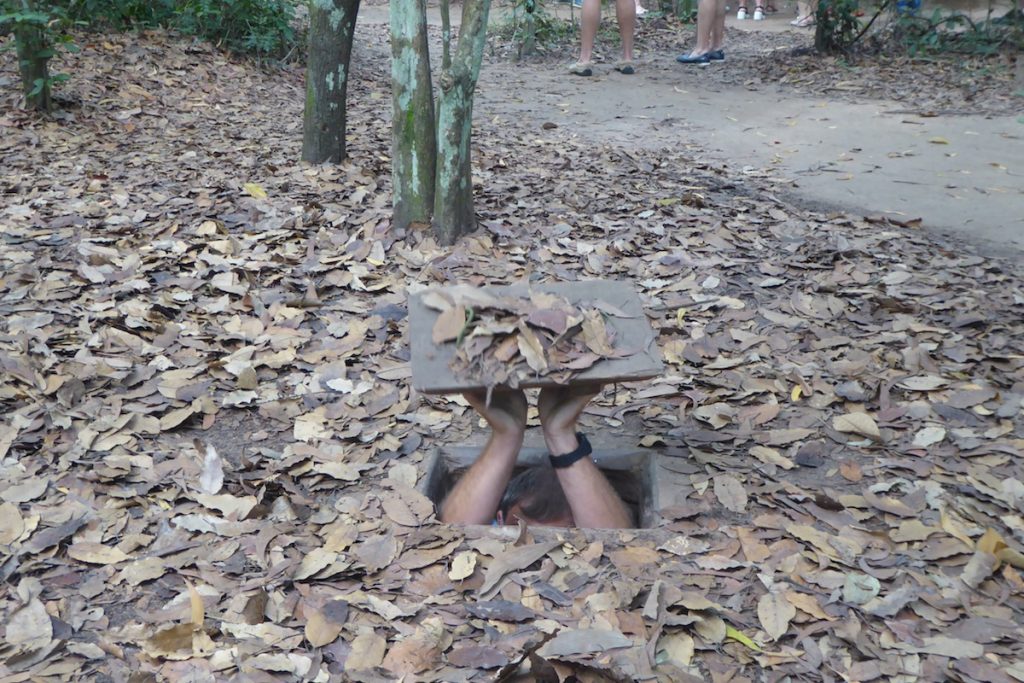
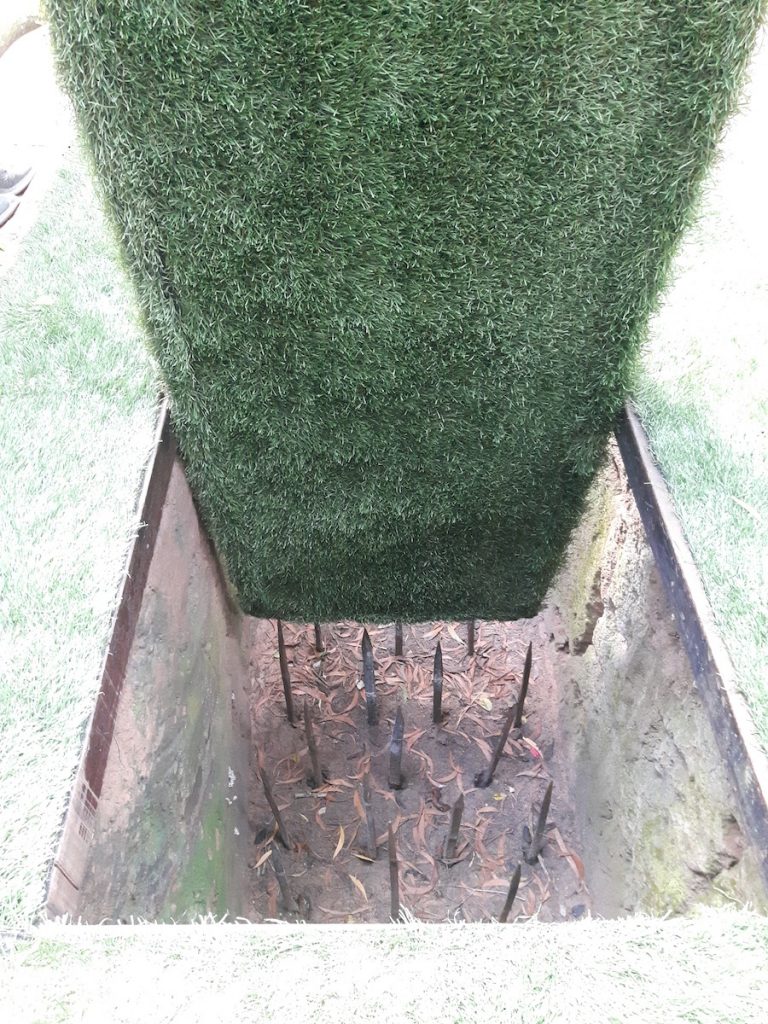
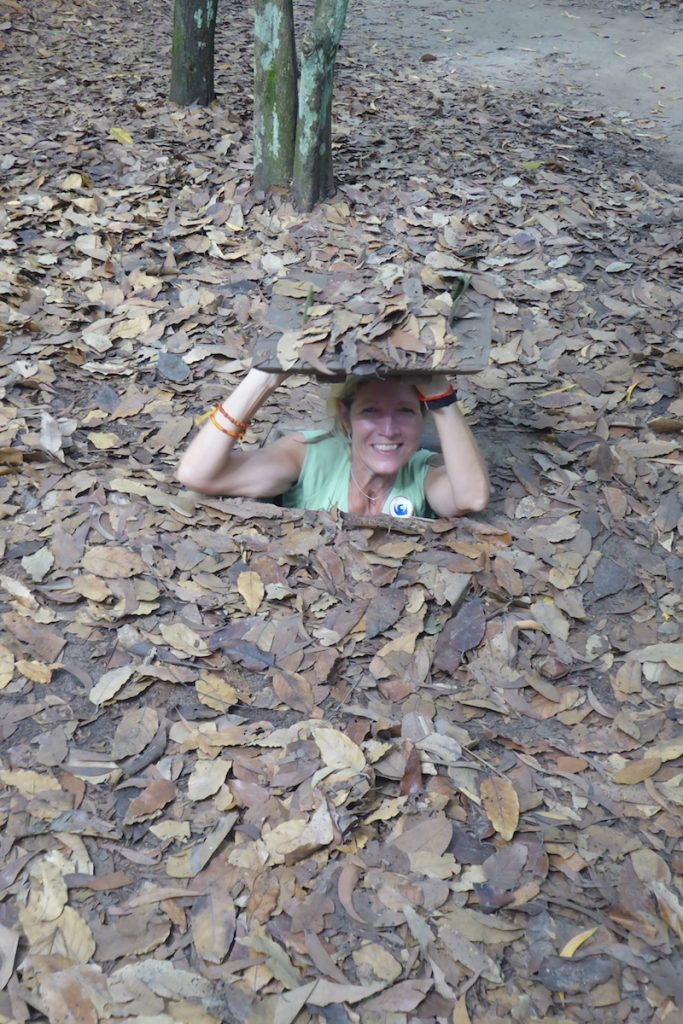
Our first stop is the infamous trapdoor, a small hole with a tiny wooden covering that is covered by foliage to camouflage it. Now I know everybody gets the chance to get inside, but I was genuinely worried I might get stuck. That feeling was not helped when Helen volunteered to be the first to try and she seemed to only just fit. I kept quiet until our effervescent guide pointed and said “your turn”. So, sitting on the edge, feet dangling, I dropped into the hole and stared to crouch down. When my chest reached the ground it did fill the small hole and I could have easily lifted my feet up and not fallen through. However, and this amazed me, by twisting sideways and lifting my arms I did actually squeeze through the gap. Closing the lid it was very dark and I was still a bit concerned about escaping again so I immediately set about getting out. Again a bit of a squeeze, but I made it. Phew.
We then proceeded to see some of the ingenious (but vicious) traps, weapons factories, kitchens (they dug tunnels so that smoke emerged from the ground a distance from where the fires were) and finally the tunnels themselves.
This time, fortunately, our leader said that I was too big to go down to level three (the lowest and smallest) but that I could go to the first levels. Now I’m not really claustrophobic, but in these tunnels, even the topmost ones, you constantly have to stoop, your shoulders rub on both walls (well mine did) and you cannot turn around. And they’re hot, humid and dark. As you turn a corner and leave a light behind you’re pitched into darkness. If you want to turn around, you can’t, there’s only one way to go and that’s forward. Twenty meters was enough for both of us and we emerged back into daylight hot and sticky from our brief underground excursion.
I’ve no idea how anyone could live in those conditions for an hour let alone days, weeks and months on end. Emerging at night to create havoc and disappearing during the day. It gives you a real feel, even though it’s all now very tourist focussed, for the ingenuity of the VC and of how difficult and frustrating an opponent they must have been. Whilst it is obviously a very serious place and subject, it is also quite a fun place to visit now. As long as you remember why the tunnels were built, and the pain endured by both sides.
For the afternoon we hopped back on out AC minibus to drive back across HCMC to the Mekong Delta to hop on a boat.
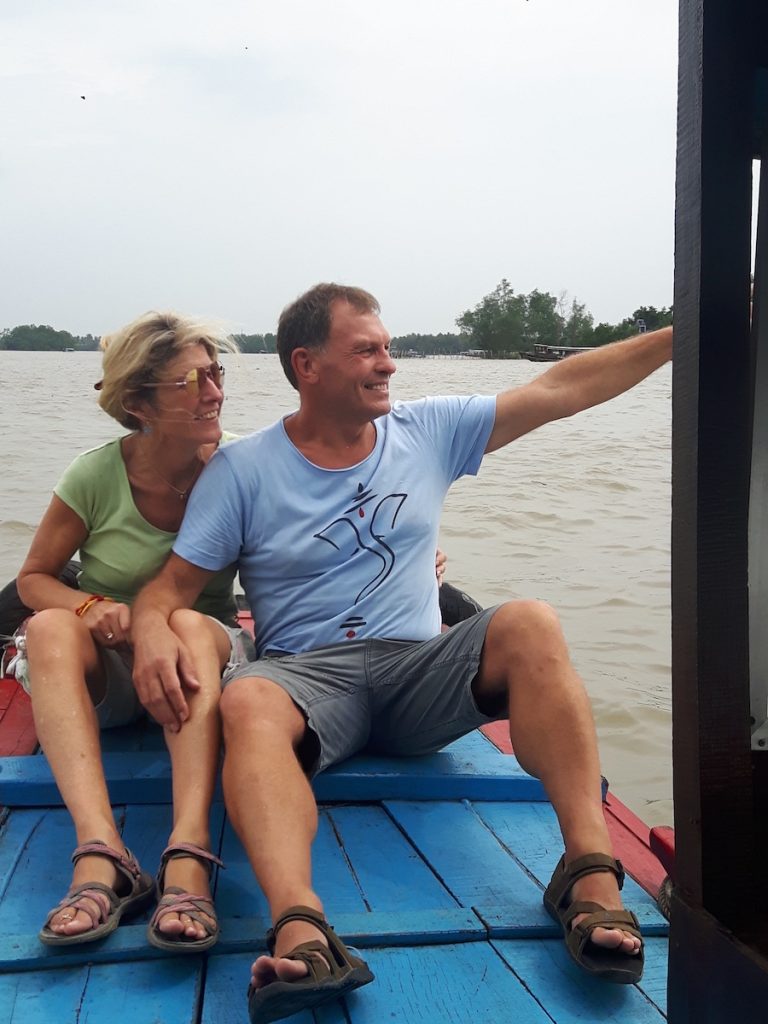
It was a boat, but it probably wasn’t the most stable boat I’ve been on. As we head out across the river (mercifully it’s not excessively wide here) little miss dynamite insists that we all take turn sitting on the prow for photographs. We went on three different boats during the course of that afternoon and she consistently badgered everyone on board to strike a pose.
The afternoon was filled with visiting a coconut candy factory to a rowing boat ride through the mangroves.
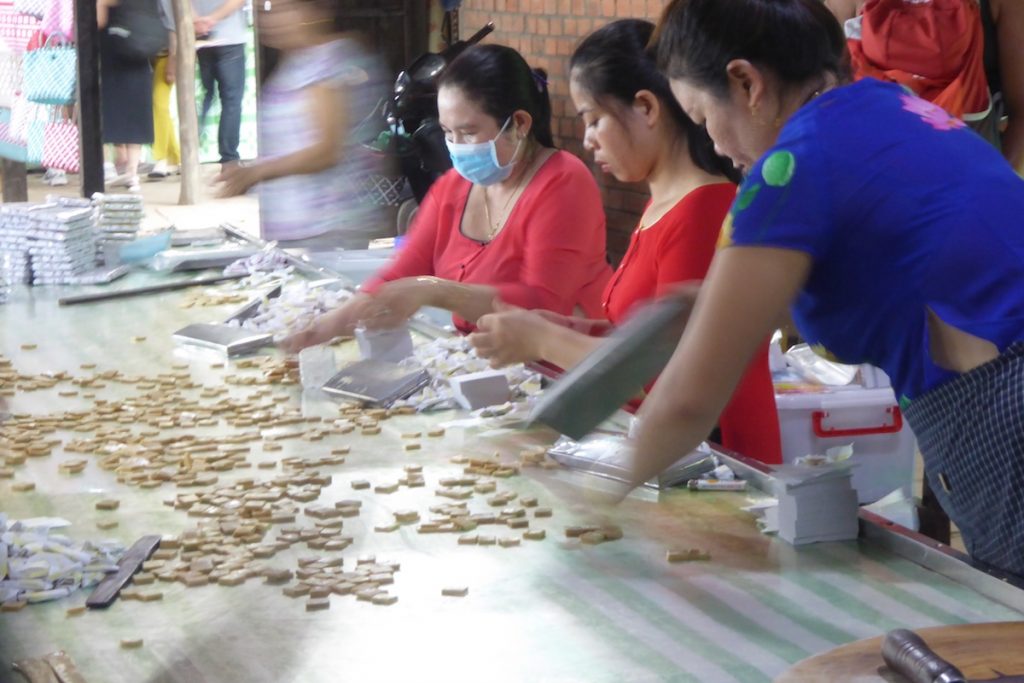
Next, Vietnamese lunch. Whole fish, shrimp, rice, etc. Then a wander round looking at the caged crocs, porcupines and other animals sadly there as tourist attractions but looking very sad. We also grab some bikes and go for a quick cycle along the lanes. After that were were paddled up the river through the mangrove trees in a small boat. A quiet relief from the chugging diesels that we’d heard constantly since we boarded before lunch.
Chocolate. They also make chocolate here (not at all bad) and we have chance to sample some. None of that Cadbury’s Milk stuff, this is 80% plus cocoa and very smooth. The chilli version is particularly good…
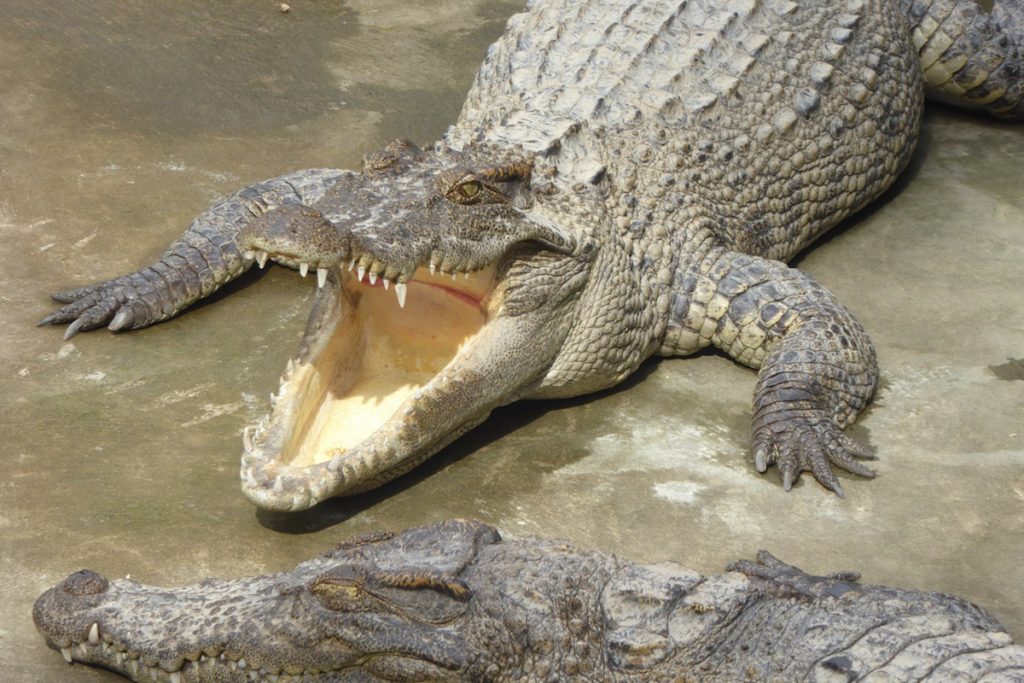
Behind the chocolate ‘factory’ somebody notices a large cage with an even larger snake in it. There were snakes at the lunch stop, but here a young girl, seemingly not much bigger than the snake, asks if we want to hold it. A number of the group are keen so the snake, a python probably 2.5 meters long gets passed between us. If you’ve never held a snake, they’re soft and warm (as opposed to cold and scaled) and completely dry. It’s a weird experience feeling the strength of it curling around you and moving so gracefully. The moment passes and I pass Mr Snake on to one of the guys who wants to take his own selfie!
The amount of use they get from a coconut is incredible. The outer husks used for mats, shells for fuel, water for drinking, oil for cooking and the pulp from the flesh for candy (after squeezing it – the residue is used in animal feed).
The candy, wrapped in rice paper, comes in many varieties and is actually quite tasty. We liked, and bought, some peanut candy.
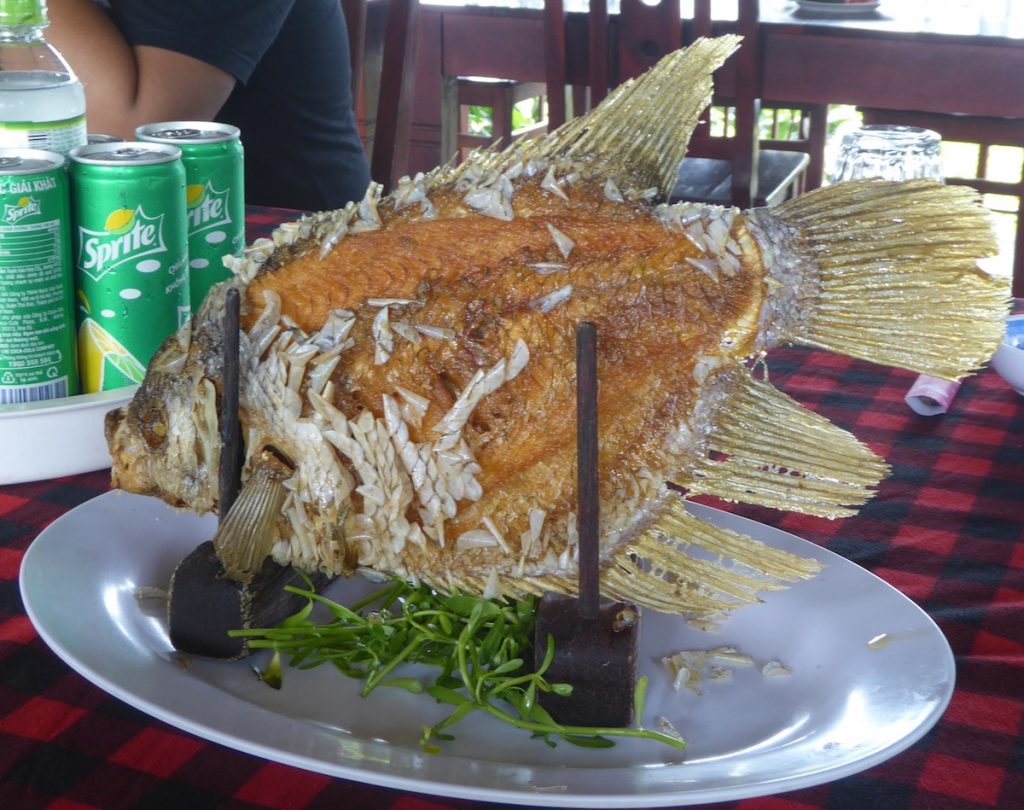
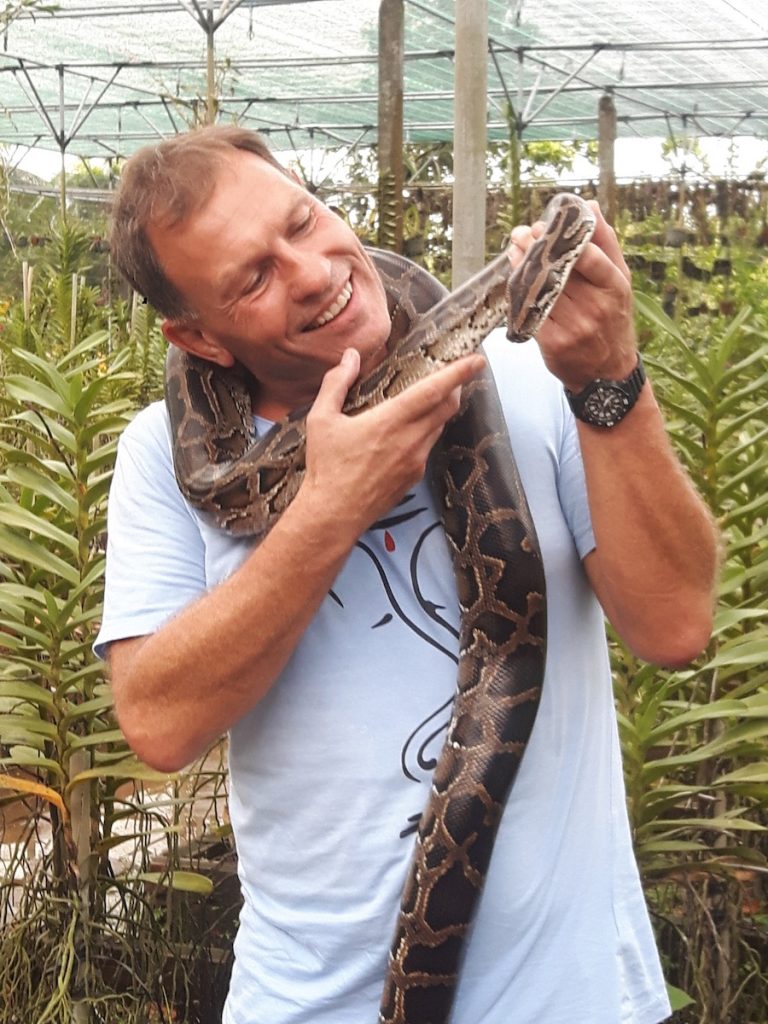
That brought the day pretty much to a close. Our wired guide was still trying to get us to take photos everywhere and by the time we returned to HCMC it was dark and late.
We didn’t actually see too much of the city itself, but it is another place in the region full of history and, as we found from our day out and about, is very diverse. It is busy though, and it was here we were first introduced to the motorcycle mayhem of Vietnam and the practical challenges of actually walking the streets. More of that when we get to Hanoi, but first, it’s off to Hoi An, for a break in the old town and on the beaches nearby.
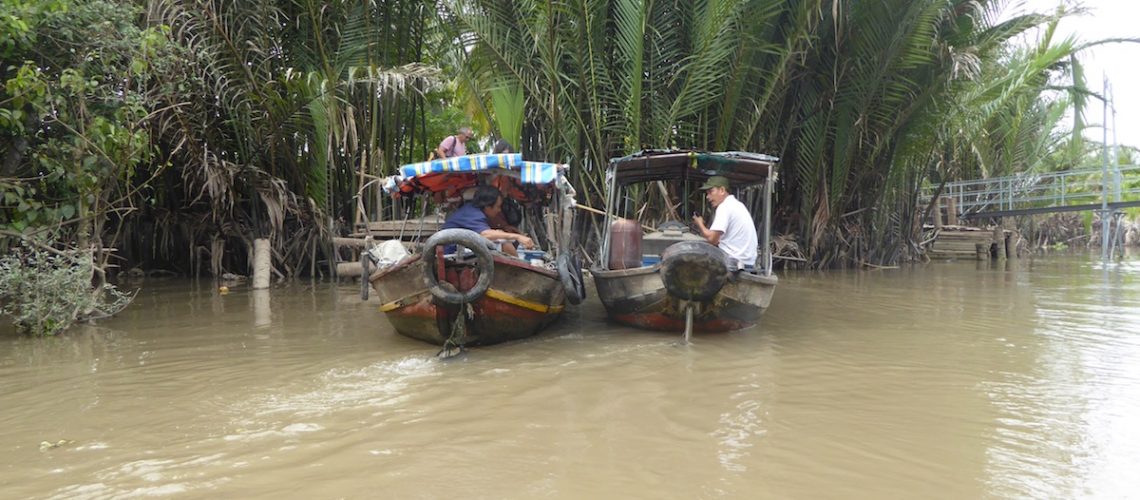
1 thought on “Ho Chi Minh City 🇻🇳”
Didn’t know Jon was a snake charmer! :o)